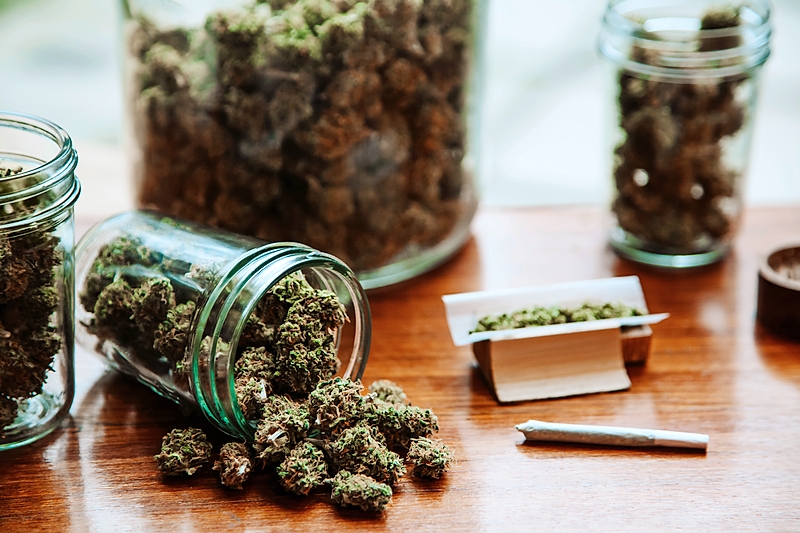Cannabis Q&A
By Naperville Magazine
November 2019 View more 630
By Christie Wilhite

Illinois lawmakers who worked to allow the recreational use of cannabis envision a more-just state where minorities and the poor aren’t being targeted by the prohibition of a common drug—one that may be less harmful than alcohol.
But detractors fear the Illinois we’ll see after the law takes effect January 1 will be a place where drug culture is normalized and police are left to navigate a minefield of legal questions the legislation doesn’t answer.
As suburban communities discuss whether to allow future recreational cannabis sales, we talked with Naperville Police Chief Bob Marshall and City Attorney Mike DiSanto to explore the impact the law might have locally.
Generally, what changes when the law takes effect on January 1?
Currently Illinois allows for medical cannabis use, and recreational users found in possession of up to 30 grams of cannabis receive a citation similar to a traffic ticket, Marshall says. Beginning January 1, recreational users 21 and older can possess up to 30 grams of cannabis flower, five grams of cannabis concentrate, and 500 milligrams of THC (the active element in cannabis) when infused in other products. Visitors to Illinois are allowed half as much and are not permitted to leave the state with it.
“Underage use and possession will still be illegal in Illinois. Those laws are still in place and will be enforced,” DiSanto says.
The law also prohibits cannabis use near someone underage, as well as near on-duty school bus drivers, police officers, firefighters, or corrections officers.
Where will smoking and cannabis use be allowed?
The law allows use only on private property, and bans use in cars and in public spaces like parks, schools, and city streets. Landlords and condo associations will be allowed to ban use as well.
“It’s similar to the laws governing alcohol use, but in some ways, it’s stricter,” DiSanto says. “You can’t ingest it in a restaurant or any public place.”
But Marshall points out that the law doesn’t define “private property.”
“It’s not clear what that means. Is that only indoors, or can you smoke on the back porch or in your driveway? We’re still trying to figure out what it means,” Marshall says. “Clarifications could be brought about by case law. Officers may have to cite someone and have it run through the court system for a ruling.”
Marshall says he can envision a homeowner hosting a gathering where people are smoking marijuana on private property, but the smoke and smell drift into the neighbor’s yard, irritating nonusers and testing the limits of what it means to use “near” someone underage.
“That’s where we’re going to get the calls,” he says. “And parties where people under 21 are present, we will be monitoring that just as we do with underage alcohol use.”
Down the line, the law allows businesses with recreational sales licenses to apply for permits for onsite consumption, opening the door to cannabis bars or restaurants serving cannabis-infused food, but DiSanto says officials haven’t seen that pursued yet.
Will stores be popping up all over the suburbs?
Initially recreational licenses are limited to existing medical dispensaries, which can apply now for those licenses. New vendors can apply for one of 75 dispensing licenses that will be available beginning May 1, and another 110 licenses available beginning December 21, 2021.
Municipalities also are able to opt out of recreational sales. “The state has given us control over recreational cannabis businesses, and that’s the big issue before municipalities,” DiSanto says.
Many local leaders are taking a wait-and-see approach, saying the state gave local governments little time to plan for what recreational sales and use would look like in their towns.
Naperville has opted out until voters weigh in by referendum. The 3C Compassionate Care Center on Quincy Avenue was among the first medical dispensaries in the state to receive a recreational sales license, but it will not be able to begin general sales while the city’s ban remains in place. North Central College has announced cannabis will continue to be banned on campus.
Similarly, Lisle is considering a local ban while eyeing a referendum. Bolingbrook has opted out, and Wheaton and Bloomingdale plan to. Meanwhile, St. Charles, Bartlett, Lombard, and North Aurora plan to permit recreational sales.
“In the zoning code, there are regulations of medical cannabis dispensaries, but the city doesn’t have regulations specific to recreational sales,” DiSanto says. “If that’s allowed in the future, I would expect requirements similar to the existing laws for medical dispensaries, and there are limits in the [state] law.”
In Naperville, a medical dispensary is a permitted use in some industrial zones and could be allowed in some commercial areas, giving city officials some discretion over whether it would be appropriate in a specific location, DiSanto says.
What other concerns does the law enforcement community have?
Active with the Illinois Association of Chiefs of Police, which opposed the legislation, Marshall has been looking at the impact recreational use has had on communities similar to Naperville in Colorado, California, and Washington state. They’ve seen increases in driving under the influence, crashes and traffic fatalities, as well as in underage use and in overdosing, he says.
“When I was growing up and friends were putting on the pressure, I could always fall back on, ‘It’s illegal and I don’t want to break the law’ as an excuse,” Marshall says. “Kids can’t use that anymore. I’m just concerned this will make it seem acceptable for them.”
Illinois has a zero-tolerance policy for driving under the influence of cannabis, Marshall says, but testing is an issue. There isn’t a reliable roadside testing system for cannabis (like the Breathalyzer test for alcohol), and cannabis stays in the system beyond the effects of impairment. Police departments will be relying heavily on the experience of officers who are drug recognition experts, a designation achieved through a 40-hour training course, he says. Naperville currently has one officer with DRE training.
Before the law takes effect, “we’ll be talking to the state’s attorney’s office about when we stop someone who appears to be over the limit and impaired [to ask] what kind of evidence will they want to see,” Marshall says.
The law also creates a task force to establish best practices for determining whether a driver is under the influence. “The good thing is that we have models from other states that we can learn from,” Marshall says. “We’re trying to slow the process down and work through as many issues as we can.”
How does the law go beyond the decriminalization law of 2016?
Not only will possession of personal amounts of cannabis be legal, but records automatically will be expunged of past citations, arrests, and convictions for possession of amounts that are allowable under the new law—so long as the possession was not connected to a violent crime. People convicted of possession of larger amounts also can petition for expungement in the absence of a violent crime.
The law also makes it easier for members of marginalized communities to become involved with the legal recreation cannabis business, by lowering startup costs and giving added weight to their licensing applications.
Learning from Colorado
A look at a 2018 report that was published by the Colorado Division of Criminal Justice Office of Research and Statistics five years after legalization in that state recognized the challenges involved with interpreting data. Its executive summary cited a lack of historical data, enforcement of conflicting regional laws, and decreasing social stigma (which can affect reporting trends) make it difficult to translate the findings (shown below) directly to outcomes.
52% – Decrease in marijuana arrests between 2012 and 2017
85 – Police officers trained to recognize drug use in driver behavior from 2012 to 2018
15% – Decrease in DUI citations issued from 2014 to 2017
153% – Increase in fatalities with cannabinoid-positive drivers
15.5% – of adults used marijuana in the past 30 days (compared with 13.6% in 2005 to 2006)
2,696 – Hospitalizations related to marijuana (compared with 803 in 2001 to 2009)
266% – Increase in state revenue from taxes, licenses & fees
Source: “Impacts on Marijuana Legalization in Colorado: A Report Pursuant to Senate Bill 13-283,” Colorado Division of Criminal Justice


